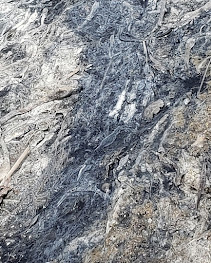From: Why did the Tasmanians stop eating fish? from Scienceblogs.com
Implications for ancient Georges Bank
Georges Bank is a very large shallow area in the North Atlantic, [around 8,050 square miles.] , that serves as a fishing ground and whaling area (these days for watching the whales, not harpooning them) for ports in New England, New York and Eastern Canada.
Eighteen thousand years ago, sea levels were globally at a very low point (with vast quantities of the Earth's water busy being ice), and at that time George's Bank would have been a highland region on the very edge of the North American continent, extending via a lower ridge to eastern Massachusetts and Rhode Island, and separated by a low plain (covered in part by glaciers) to the rest of New England.1
As sea levels began rising around twelve thousand years ago, George's bank became a narrower peninsula and eventually an island visible from the mainland. We know that people lived on this island because artifacts of early Native American groups have been dredged up here, along with the teeth of Pleistocene elephants and other items.
Eventually, the island would have been too far from the shore to see, although one might expect people living on the island or the mainland would have known about the other lands, and probably about the people on them, as there is good evidence that maritime activity was fairly intensive in this region. Indeed, it may well have been the existence of George's Bank that fueled the maritime activity that was apparently much more intensive between five and seven thousand years ago in this region.
But eventually, it is quite possible that as post-glacial sea levels rose, and the island that was to become George's Bank became smaller, that it became unconnected in all the ways one might expect, including the movement of semi aquatic land mammals (humans included in their own way), human memories, and so on.
What happened at the end, when the island finally went under, assuming that humans were still living there? Did these humans have a viable long distance maritime culture, allowing them to get on boats and, with some risk but also a reasonable chance of success, move to Cape Cod or Maine or what was to someday become Boston? Did they have boats only adequate for local transport, but still attempt, with much greater risk and much lower chance of success, to go somewhere? And if so, if they were not any longer a maritime people, did they even know which way to go? Did they just become inundated by the sea, perhaps living as the people of The Maldives live today, on a very low island in the middle of the sea, no one ever stepping on land more than a few feet above sea level, but then become wiped out by some singular event, like a tidal wave or a very bad hurricane?2 Or, perhaps, were these people wiped out before they ever had the dubious opportunity to experience the final inundation of their lands? With what must have been a shrinking population under conditions of shrinking resources, it is quite possible that warfare, pestilence, and other nasty things could have depopulated "George's Island" centuries before the watery Apocalypse.
And, just as interestingly, what happened before the final inundation? Not just before, but over the centuries before, as the specific result of being cut off from the mother mainland culture? Did the George's Bankers become a culture distinct from that on the mainland? Did this culture either posses features not seen elsewhere, or lack them because they never arrived to this remote place? Or, did the George's Bankers lose certain traits that the mainlanders kept because ... well, because of some reason or another?
Nobody knows. But we to know the following: The story of George's Bank is a story that probably played out in dozens of locations around the world where segments of large land masses (mainly continents) were at first cut off via land, then via eyesight, then perhaps via regular maritime travel, and somewhere along the way, via the complete cessation of medium and long distance cultural interaction of the kind in which most other people on the planet were engaged. In some of those cases, total inundation happened, but in others, not. And thus, there are two classes of islands occupied by humans: Those we have discovered and moved to, and those that were not originally islands and became so while we were there.
The most famous example of the first is probably the numerous Pacific Islands running from Melanesia to Polynesia. The most famous example of the second is probably Tasmania.










